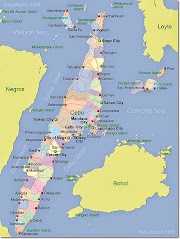Pinamungahan's scenic beach.
The Santa Monica Parish Church in Pinamungajan.
Nestled along the mid-west part of the island, folded amongst its picturesque mountains and beautiful coastline is the town of Pinamungajan.
Pinamungajan is located in between the town of Aloguinsan and the city of Toledo and Tañon Straight in the west. It is approximately two hours drive away from Cebu City and can be reached via the Naga-Uling Road and Carcar-Barili route.
The town was established in 1815 under the Spanish colonial government. The town’s name originated from “pinamuhuan”, which means a worker’s share of the harvest, evolving into Pinamungajan through the years. As its name suggests, it is a place of bountiful harvest where one can see people working together, enriching the term bayanihan to this day.
It is primarily an agricultural town and is one of Cebu’s largest coconut producers. In celebration of this bountiful harvest, the Pamuhuan Festival is celebrated every first week of May in time for the town’s fiesta celebration honoring patroness St. Monica. The festival highlights not only its rich history as a farming community but its natural wonders.
These natural wonders are the reasons why adventurers keep on coming back to Pinamungajan, an open traveler’s secret.
In the mountains of Lamac, one of the populous and highly urbanized barangays in the town, is concealed riches waiting for valiant souls to uncover, to plunge into the dark crevices of its more than one hundred caves.
Kublai Espina of Cebu Speleological Association (CSA) says that Lamac has massive karst formation and has lush vegetation. Put the two together, one is bound to find caves that are literally alive and growing.
“Growing means its speleothem-crystal formation is still forming, and I think this is one reason why one visits its (Lamac) caves, particularly Kamangon to see (and record) its unique speleothem formation and its growth. As a frequent visitor to that cave I have noticed how fast its crystal forms – it has become [even more] beautiful as years pass by,” Espina added.
Kamangon cave, one of the most visited, is called so after the Cebuano term kamang (crawl), because one has to touch the belly to the ground, wiggle and squeeze for at least a few feet to get inside.
For a local tour guide fee of P200, one can marvel on huge stalactite and stalagmite formations. And with a little imagination, some stone formation takes the form of a rooster and a tooth.
The sparkling ceiling and walls is very enticing to touch, but you just have to settle with admiring it from afar. The fingers, one is warned, has oil and dirt that could damage the formations.
Just a piece of advice, for ordinary tourists who are no experts in caving, it is discouraged to enter the cave without an experienced guide and the required safety equipment like helmets and head lamps. Coordinate with Lamac’s barangay officials, and a local guide will be provided.
The local government also sets a limit to the number of people that can go inside at any one time to protect the caves.
After a sweaty exploration, a trek to Udlom and Sinungkulan Falls is just a walk away from Kamangon Cave, and offers a refreshing treat.
Sinungkulan Falls was the barangay’s public bath in the olden times, apart as the source of water for the irrigation system of their rice fields. Today, the falls still holds its beauty and locals still enjoy bathing in it its clear, cold water.
For those who want to just unwind and take a rest, Lamac has the Hidden Valley Resort, owned and managed by the acclaimed Lamac Multi-Purpose Cooperative. In 2003, it started its operation as a training center for members until it became a fully-operational resort. It has facilities for trainings and conferences, four swimming pools, a covered court, a fishing area, four function rooms and sixty guest rooms.
For local repast, especially for first timers, never miss the welcome reception of Lamac’s special budbod and biko, native sweetmeats made from rice.
A view from the resort also lets one enjoy the magnificent Udlom Falls and the mountain walls of Lamac.
Aside from its terrestial wonders, Pinamungajan also boast of its rich marine resources. A 20-minute boat ride from Tajao Wharf will take you to the one-hectare pearlescent Camapalabo Islet, a sand bar, resting amidst hectares of diverse marine flora and fauna.
During low tide, this white sand strip is visible from the shores of Pinamungajan. Arrange a visit through the local government or with the Bantay Dagat team. The government charges a boat parking fee for the average-sized motorized bancas.
To end your sojourn on a perfect note, sundown in this side of the island is also a must-see when you are in Pinamungajan.








4 Comments
i like lamac pinamungajan
ReplyDeletepinamungajan is a very nice place
ReplyDeletePinamungajan is blessed with beautiful beaches, waterfalls, caves and especially Lamac Hidden Valley Resort...
ReplyDeleteTama! That's why we should be proud for having this Places
ReplyDelete:)